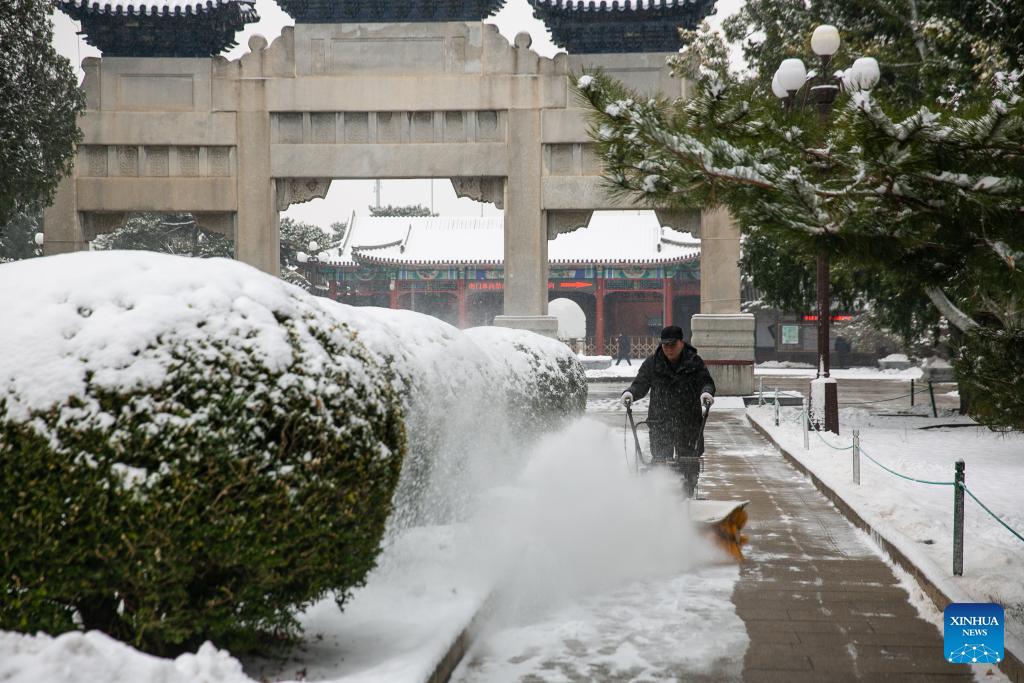

A staff member clears snow at Zhongshan Park in Beijing, capital of China, Dec. 13, 2023. [Photo/Xinhua]
style="text-align: left; margin-bottom: 15px;">In response to the latest cold spell and heavy snowfall, authorities in northern China have launched emergency response measures to guarantee the operation of transportation and the supply of power and heat while ensuring people's uninterrupted lives.
Intense snow across Beijing, creating alerts for blizzards, cold spells, and frozen roads, has prompted road closures and the suspension of classes and some train services on Wednesday.
Beijing Huanwei, in charge of urban sanitation management, has prepared a fleet of over 1,000 sets of snow sweepers and ice-removing facilities and a maximum reserve of snow-melting agents for blizzards to meet any emergency. As of noon, thousands of people had been mobilized to do cleaning rounds.
China's meteorological authority issued a yellow alert for blizzards on Wednesday, forecasting intense snowfall in the north.
Parts of Shaanxi Province, Shanxi Province, Hebei Province, Beijing, and Henan Province will experience heavy snow from Wednesday to Thursday morning, according to the National Meteorological Center (NMC).
The NMC also issued a new yellow alert for a cold wave, predicting that temperatures in most parts of China will drop by 8 to 12 degrees Celsius from Wednesday to Saturday.
In Hebei's city of Xingtai, an emergency response has been activated to conduct non-stop snow removal operations on traffic arteries.
"We use both mechanical and manual ways to clear the snow and work around the clock in groups to ensure the safety and smooth operation of the traffic," said Li Hongqian, who works at the local highway maintenance center.
Lian Feng, deputy director of the center, said they spread snow-melting agents and non-slip materials in advance on the road sections prone to safety hazards such as sharp bends, steep slopes, large bridges, and tunnels and have set warning signs to remind drivers.
The power department in Hebei has deployed more than 8,700 personnel, 1,060 vehicles, and 329 generator cars in case of any emergency. Drones have also been sent to check the operation of the power supply facilities.
In Henan, over 1,800 bus routes had to be suspended due to the blizzard. The provincial civil affairs department sent thousands of people to conduct regular street patrols and distributed over 10,000 supplies for more than 3,800 people needing help.
Emergency response measures have also been adopted by the Henan housing and urban-rural development department, which has carried out preventative anti-freeze measures on 54,000 water supply facilities and checked relevant facilities to guarantee the water and heat supply.
The agricultural department of Shuozhou City, Shanxi Province, has taken proactive measures to address the impact of snowfall and dropping temperatures on fruit and vegetable production.
Agricultural technicians have been mobilized to conduct thorough assessments of crop growth in greenhouse facilities and provide on-site guidance on scientific farm management and protection in the cold weather for farmers.
"We guide farmers to reinforce greenhouse facilities, implement thermal cover and take multiple measures, such as spraying nutrients and installing warming lamps," said Zhang Jianrong, deputy director of the agricultural and rural bureau of Shuocheng District in Shuozhou.
Authorities will remain vigilant concerning weather changes, strengthen early warning forecasts, and enhance emergency readiness to address unforeseen events promptly, aiming to ensure the success of winter greenhouse agricultural production and secure the stable supply of agricultural and sideline products for residents, according to Zhang.
China has a four-tier, color-coded weather warning system, with red representing the most severe weather, followed by orange, yellow, and blue.
